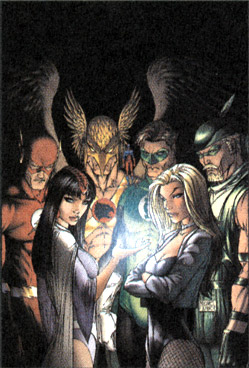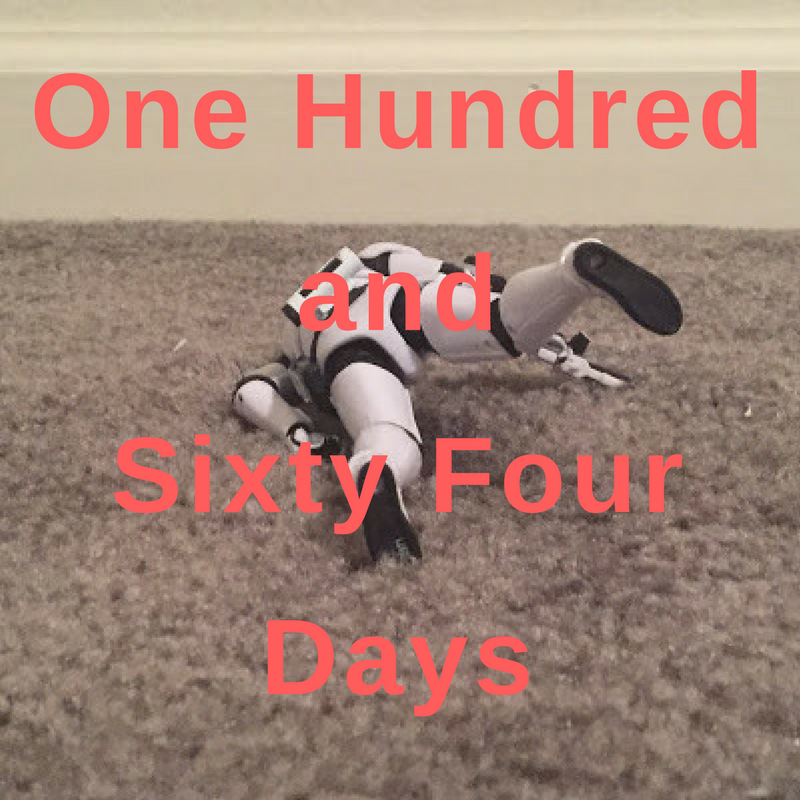
Travels With Larry Part XIX
A Brief Pit-Stop On The Road To Nirvana
I’ve been spending a lot of time reading and digesting the output of AiT/Planet Lar comics for quite a while now. Some of you who have been following this feature for a while might be wondering just why I am still keeping at, just why I am bothering to devote so much of my time and effort to reviewing books that most other bloggers dispatch in short order. Why be so, well, critical all the time?
As with many things in this here comics world, the answer comes by way of Kim Thompson and Tom Spurgeon. A few years ago (actually, five years ago if the date on the website is correct) Thompson wrote an essay for the Comics Journal that said, in as many words, More Crap Is What We Need. By this he didn’t mean absolute crap, merely middle-of-the-road genre fiction, the kind of unpretentious and enjoyable entertainment that formes the backbone and bedrock of every other popular medium.
As an industry, we’ve spent the last twenty years or so working at a furious pace to remove the taint of juvenilia from the medium. As a result of this unstinting hard work and laboriously ascetic worldview, we have succeeded in creating a world where, in at least some limited capacity, Comics Are Art. It may be fragile and it may be slightly shallow in places, but there is an honest-to-God artistic community growing up around English speaking cartoonists in North America.
Ten years ago the publication of Louis Riel, The Fixer, Persepolis, Quimby the Mouse and the collected Frank and Palomar volumes would have each been cause for amazing celebration. Each of these books, if they had landed twenty years ago, could have created (in my opinion) the kind of fervor that followed the release of Maus. But they were all released in the space of one single calendar year during 2003, and we all pretty much took it in stride. This is what our medium has accomplished.
But it’s not enough that we produce Art of the highest caliber. Sure, that is the reason we’re here at the end of the day (or at least the reason I’m here, I don’t know about you). But as
Kim Thompson says so eloquently:
"[Comics] need a middle ground somewhere between Utter Shit and Great Art. Otherwise the marginalization will continue, and the genre stuff will turn into modern network TV (i.e. horrible beyond belief) and the good stuff will turn into modern poetry, and we'll all be fucked."
Perhaps it might be damning with faint praise to refer to AiT/Planet Lar’s output as "somewhere between Utter Shit and Great Art". But that’s more or less where I imagine Larry Young himself sees himself. There’s not an AiT/Planet Lar book I’ve read yet that I think would qualify as quote-unquote Great Art (although I will hold my tongue on that note – the collected Demo, whenever the hell it gets here and whatever form it takes, might just be a breakout book for the company with the art snob crowd). But on that same note there’s not a book from the company that I have yet to read that seemed anything less than genuinely sincere in its effort to entertain, amuse and divert the reader.
Now, of course, intentions don’t amount to shit when we’re talking about Art . . . but they do mean a great deal when we’re talking about marketing. This is Larry Young’s secret. This is why he annoys the living piss out of some people. This is, not coincidentally, why he’s making a comfortable living publishing black & white graphic novels out of his house, and why the print run of every new book he releases is bigger than the last. Larry Young saw an opening and he took it. It’s as simple as that. He perceived an industry where a vicious intractable dichotomy existed between the High Art and the Utter Shit. You were either with Fantagraphics and D&Q or you were sitting outside the Android’s Dungeon every Wednesday morning and waiting for Paul Levitz and Joe Quesada to shit down your collective throats.
Any moron will tell you that that is not a healthy industry.
Imagine a world where movie theaters only showed to kinds of films: A+ art pictures or grade Z genre schlock. There are people who love to watch nothing but high quality films, refusing to sully their palates with anything but the most thought-provoking world cinema. There are also folks who really, really love nothing better than bad teen horror flicks, raunchy stoner comedies and late-night Cinemax soft-core porn. But that’s not the movie industry. Except for rare instances, movie theaters make their bread and butter off the stuff that Average People want to see.
People like family comedies and historical dramas and police procedurals and action extravaganzas and sci-fi blockbusters and childrens’ adventures and westerns and romances and horror and biopics and detective thrillers. Every one a genre that you would easily expect to see on a cinema marquee, every genre that you would expect to see on your television or on the stands at your local bookseller. And almost every single one of them notably absent from the shelves of your local comic book store.
In his recent lengthy article on the company (in issue #260 of the Journal), Tom Spurgeon opined that "Young and [Mimi] Rosenheim have the freedom to publish what they like; they seem to prefer quirky, broad-based entertainment to strict, idiosyncratic artistic achievement." Anyone attuned to the Journal’s usually high critical standards may see this as a backhanded compliment. But I don’t really think this is an indictment of the company so much as a pure statement of fact.
Larry Young projects the image of an Everyday Guy. As Spurgeon so ably puts it:
"If one is to believe the online rhetoric around Young, spending time near the publisher would be roughly equivalent to joining a comic-book fraternity, where comics chat is interspersed with talk of fine liquors to be consumed and aggressively macho movies to be celebrated."
It only makes sense to refer to this as an "odd subset" of comics culture when one considers just how odd the majority of comics culture is. Something like what Spurgeon describes may seem alien to the hermetically sealed world of comics fandom, where every day is 1964 and girls is icky, but in the real world this is the type of chummy mystique that sells product. People want to be cool.
Only in comics could it be considered unusual to appeal to the general public’s sense of social inadequacy. That may seem like a harsh term, but lets look at this a bit more closely. Why is Playboy still considered cool after all these years? Well, besides the naked women. The fact is that there’s so much more explicit pornography available than you can find in Playboy, and its usually racked less than a foot away at that. So why do they buy it? It has something to do with those ads that they always run (or at least they used to always run them, back when I paid attention to the magazine): What Kind of Man Reads Playboy? Why, a dashing, well-dressed, intelligent and suave fellow, that’s who, who is usually doing something very fun in a sophisticated manner with a beautiful woman on his arm. Even if you’ve never opened up an issue of the magazine, you probably know that stereotype, because every time Hugh Hefner appears on the television or in a photograph that’s the image he’s selling.
When you buy an AiT/Planet Lar comic, you get the feeling that Larry Young himself is slapping you on the back and offering you a cigar from his own personal stash. He’s a friendly, outgoing fellow who wants nothing more than to bend his elbow for a while with some good friends and discuss the latest baseball scores. Whether or not the real Larry Young fits this profile is irrelevant. That’s how he does what he does.
At some point, however, this is going to backfire. The fact is, comics are selling well in bookstores and general media outlets. From what Young has said, much of the company’s sales come from outlets that wouldn’t know a Previews order form if it hit them on the head. There’s going to reach a point where he’s not going to be able to hand-sell every comic that leaves his house. If the only impetus behind the successful publishing company is his personality, this is a fragile brand on which to build a publishing empire. At some point he’s going to have to step back and become less intimate with his customers, simply by virtue of the economies of scale that follow in the wake of success.
But until that point he is fortunate to have a birds-eye seat for the remaking of the comics industry. It would be foolish to claim him as an industry messiah or savior based simply on the fact that he sells comic books well. But the fact is that if the American industry does survive, it will be because it followed at least partly in Young’s footsteps.
There’s a point at which we can’t compete with the manga invasion, simply on the grounds of the fact that the American industry doesn’t have the library of cheap, facile entertainment at our fingertips that Tokyopop and Viz do. For better or for worse, we’re having to create our competition from the ground up. Although it must be noted that AiT/Planet Lar does not (yet) publish any books in the handy-dandy 6"x9" manga format, they do price their books quite competitively to the average manga volume. You get around a hundred pages of black and white comics at regular size for about the same as it costs to get a couple hundred pages of comics at the same price but a much smaller format. Joe Quesada has famously stated that the economic means to produce OGNs is simply not in place yet for American mainstream comics. Well, they better learn pretty damn soon or the entire market is going to outgrow the puny efforts of the "Big Two". Perhaps they should hire Larry Young to run their R&D departments.
I think I’ve been as harsh as anyone towards those AiT/Planet Lar books I haven’t enjoyed. I think, for instance, that I am the only person in the entire western world who didn’t fall all over themselves for Ursula. I did get a kick out of Planet of the Capes, however, when many intelligent and thoughtful commentators found themselves scratching their heads. This may sound bad but the quality of the individual comics is almost besides the point here. The important thing is that a gifted and insightful marketing man has found economic traction in the comics industry. If you want to start a successful comics company in 2004, I would follow Larry Young’s lead.
Spurgeon notes:
"[Young and Rosenheim] may have cruised past the point where they flesh out their line with detritus from the second Image boom and tossed-off "pop comics" and into a groove where they can settle into fruitful relationships with a select group of artists and writers, creators with the potential to evolve into superior craftspeople who can fulfill, expand, and even redefine the company’s general creative vision."
There is something slightly worn about a lot of the company’s output. For every sterling Codeflesh that they save from premature extinction, there’s an oddball like Johnny Dynamite or Sky Ape. Even some of their more prestigious projects, such as Warren Ellis’ Switchblade Honey, have suffered from a slight B-movie quality. I liked Switchblade Honey, but if you remember my review I was also extremely dismayed by Ellis’ introduction wherein he basically said the book was a tossed-off in-joke. It wasn’t perfect but it was fun, in the same way that a pilot episode of a promising television show can be: they don’t have expensive sets yet and the writing is still finding a voice, but there’s something fun that makes you want to tune in the following week. In the future I hope that Young will be able to inspire a higher degree of commitment and enthusiasm from his creators, because the commitment and enthusiasm he brings to the act of marketing even the dodgiest product demands to be met head-on. If I were a comic book writer I would want Larry Young in my corner, and with his track record I wouldn’t think of giving him anything less than my A-game.
At the end of the day it comes down to this: if you want to find the New Mainstream in comic book publishing, look to wherever Larry Young is. He publishes a lot of crap but he also publishes some real gems, with an entire spectrum of quality in between. He publishes something for everyone, and that’s is something I cannot say for anyone else in our entire industry. If there is any justice in this amoral business of ours, he will die a rich, rich man and it is not without a small smattering of professional jealousy that I say that.
(Let us merely hope that Young never divorces Rosenheim and decides to turn Astronauts in Trouble into an ongoing screed against the all-consuming power of the Marxist/feminist/homosexualist axis. Already seen that one, thanks.)
























